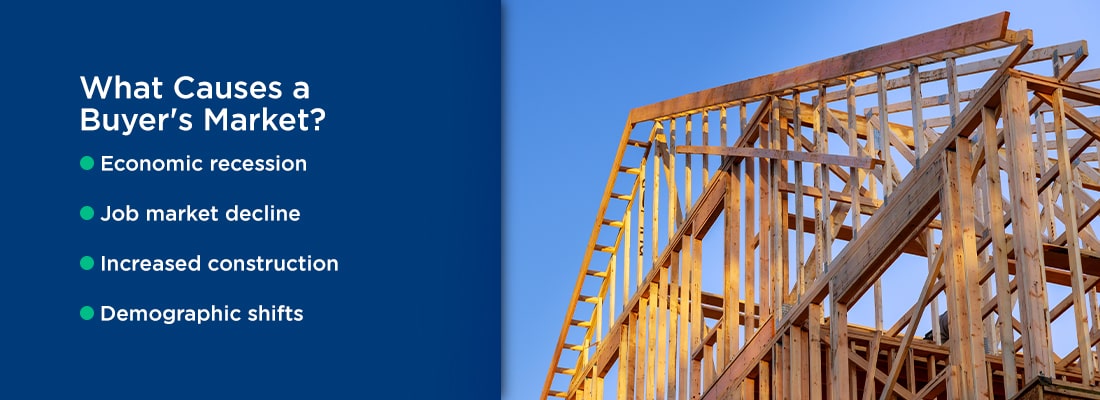The real estate market has fluctuated significantly over the past few decades, with a median sales price difference of $195,900 in the last 20 years alone. With these constant housing market shifts, it can be challenging to determine the best time to buy or sell a house.
The key to getting the best possible value for your money is understanding what’s happening in your local real estate market — whether you’re a buyer or a seller. You can do so by learning about the differences between a buyer’s and seller’s market, how to identify these market types, and effective tactics for navigating either.
Topics Covered
- What’s the Difference Between a Buyer’s and Seller’s Market?
- What Is a Buyer’s Market?
- What Is a Seller’s Market?
- How to Tell if It’s a Buyer’s or Seller’s Market
- Is It Bad to Buy in a Seller’s Market?
What’s the Difference Between a Buyer’s and Seller’s Market?
Buyer’s vs. seller’s markets are a matter of supply and demand. At its base, the housing market is relatively simple to understand, but there’s more that goes into it than these basic definitions. There are three primary differences between each of these market types.
Power Dynamic
The most considerable difference between a buyer’s and seller’s market is who has the power — the buyer or the seller. As you might have guessed, the power dynamic leans toward the buyer in a buyer’s market and a seller in a seller’s market. Why? Because in a buyer’s market, there’s more housing inventory and lower prices, giving power to the buyer. Conversely, seller’s markets enable sellers to ask for more money and encourage bidding wars, giving them the power.
Marketing Strategies
Marketing a home in a buyer’s market vs. a seller’s market requires different tactics. In a market that favors buyers, sellers and their realtors have to put in a much greater effort to make their homes stand out through means of social media, open houses, and advertisements.
Seller’s markets don’t require quite as many marketing strategies, though some level of promotion is still necessary to showcase their properties, such as professional photographs, deliberate staging, and fair pricing.
Buyer Expectations
Buyers have far different expectations when looking for a home in a buyer’s market than they do in a seller’s market. In a real estate market that benefits buyers, individuals expect to have plenty of housing options and get good deals. In a seller’s market, buyers expect a more competitive environment with higher pricing.
However, with more expensive homes, homebuyers often prefer that their end-purchases reflect their money, expecting high-quality properties like move-in-ready homes. In turn, sellers must offer houses that warrant their premium list prices.
What Is a Buyer’s Market?
A housing market where the supply exceeds the demand is called a buyer’s market. This means that though many properties are available, there’s a shortage of buyers interested in purchasing them. These market conditions give buyers the upper hand over sellers, compelling the market to respond accordingly.
In a buyer’s market, prices decrease and houses remain on the market for longer, forcing sellers to compete with one another and drop their asking prices to attract buyers in an environment where the clientele is limited. Sellers are much more willing and likely to reduce their prices in a buyer’s market to prevent them from losing a sale.
What Causes a Buyer’s Market?
A buyer’s market stems from changes in market conditions that advance homebuyers over sellers. In most cases, any situation that decreases a buyer’s urgency to buy and increases a seller’s urgency to sell will generate a buyer’s market. Some of the most common causes of buyer’s markets include:
- Economic recession: An economic recession occurs when economic activity declines significantly in a designated region for a prolonged period. This economic decline can cause homeowners to sell their houses if they can no longer afford to pay their mortgages, increasing housing inventory and shrinking the buyer pool.
- Job market decline: A dwindling job market may prompt homeowners to sell their houses and move to different locations with more job opportunities, creating a buyer’s market.
- Increased construction: Large influxes in new housing construction often result in buyer’s markets — just because homes are being built doesn’t mean there will be buyers interested in them. Real estate overdevelopment in an area often leads to an excess housing supply.
- Demographic shifts: How a certain demographic approaches the local real estate market can drastically impact supply and demand. For example, if younger people in an area decide to postpone homeownership, the buyer pool shrinks.
A prime example of one of these factors creating a buyer’s market was the financial crisis of 2007-2008. During this time, unsustainable mortgage rates caused many homes to go into foreclosure, resulting in significant price drops from homeowners desperate to sell. Supply increased drastically, but there were little to no buyers interested in purchasing properties.
Tips for Buying in a Buyer’s Market
If you’re a buyer looking to purchase real estate amid a buyer’s market, it’s the best time for you to be doing so. In a market that benefits the buyer, there are numerous tactics you can employ to negotiate a great deal and get the most value for your money:
- Take your time: You have the power in a buyer’s market. That means you can take your time browsing your options with minimal risk of losing a property you’re interested in. With a buyer’s market comes low demand for houses, so you likely won’t be competing with other interested parties and can therefore proceed without a sense of urgency.
- Weigh your options: As a buyer in a buyer’s market, you can relax and evaluate all your housing options to find a place that’s perfect for you. Knowing what’s on the local real estate market ensures that you find your ideal fit and gives you a greater ability to negotiate based on competing list prices.
- Pay attention to days on market: In a buyer’s market, real estate is likely to remain on the market for much longer than average. The longer a house stays on the market, the more you can negotiate with the seller to secure a more affordable price.
- Offer less than the asking price: Sellers are much more willing to lower their prices to close a deal in a buyer’s market. When negotiating a price drop, think about how much you want the house, how much you’d expect it to go for and how happy you’d be with the house with or without a reduction.
- Seek seller concessions: In addition to offering a lower price for a house, you can also ask that the seller pay your closing costs, which can account for approximately 15% of a home’s purchase price. You may also be able to ask the seller to impose a more flexible closing date, including appliances in the list price or add bonuses like furniture.
- Request repairs: If you notice that the house has damage but is not meant to be a fixer-upper, you can ask the seller to make repairs.
Tips for Selling in a Buyer’s Market
As a seller in a buyer’s market, you may have to be a bit more strategic in your sales plan. However, that doesn’t mean you have to submit to every buyer’s whim. Consider these tips when selling a house in a housing market that benefits the buyer:
- Optimize your marketing: It’s vital that you market your property as professionally as possible to attract buyers. Try highlighting your home’s competitive advantages, taking high-quality photos, and implementing up-to-date decor to create a polished look.
- Price competitively: In a buyer’s market, it’s crucial that your house is priced similarly or lower than other homes in the area. Because buyers have the power, they won’t hesitate to move on to the next property if your price is too high.
- Make repairs: When buyers have more houses to choose from, they tend to be pickier about their options. That’s why it’s beneficial to hire someone to conduct a pre-inspection of the house so you can pinpoint and fix any problems before listing the property.
- Consider closing costs and concessions: In a competitive market, you may have to go the extra mile by paying for closing costs or including concessions to close the deal.
- Be open to negotiation: Perhaps the most important part of selling a house in a buyer’s market is being flexible. It’s easier to close a deal when you’re open to negotiation and prepared to compromise with buyers.
What Is a Seller’s Market?
A seller’s market occurs when the housing demand exceeds the supply, meaning there are many interested homebuyers but a shortage of real estate inventory. Because there are more buyers than available homes in these market conditions, sellers have the advantage.
In a seller’s market, houses sell faster than average, requiring more buyers to compete with one another to secure a property. This higher competition often makes individuals willing to spend more than they normally would on a house, enabling sellers to raise their costs at or above the original asking price — with little to no pushback from buyers.
These housing market conditions minimize the buyer’s power to negotiate and often lead them to accept properties as-is.
What Causes a Seller’s Market?
Like a buyer’s market, there are numerous factors that can cause the real estate market to fluctuate in favor of the seller. Some of the primary contributors to a seller’s market include:
- Low interest rates: When mortgages have lower interest rates, more individuals feel inclined to buy. With lower interest rates and limited houses on the market, more bidding wars will likely occur, and more buyers will be willing to pay above the asking price.
- Job market growth: A booming job market brings more individuals to local areas seeking jobs. This job market increase attracts more people to the region, causing a greater need for real estate.
- Population growth: Like growing job markets, significant population increases also raise the demand for housing. If few properties are available during this population growth, the demand can quickly exceed the supply, giving sellers the upper hand.
- Development limits: Sometimes, local governments will implement development limits that restrict how many new houses can be built in an area, resulting in a lower housing supply.
- Decreased home construction: Even if there are no development limits in an area, there may simply be a shortage of new home construction, resulting in decreased real estate inventory.
For example, the year 2010 marked significant growth in San Francisco’s technology sector, bringing throngs of people to the city in search of higher-paying jobs, creating an influx in housing demand. However, due to the local government’s development laws, the supply remained low. As a result of San Francisco’s job market growth and construction limits, sellers gained an extreme market advantage, with the home values rising by over 85% to the previous decade.
Tips for Buying in a Seller’s Market
If you’re preparing to buy a house in a seller’s market, you may have to take some extra precautions to get the best price:
- Act fast: If you find your dream home, it’s crucial to act immediately to minimize the risk of losing a listing. In a seller’s market, properties go fast — sometimes even the day they’re listed.
- Prepare for bidding wars: You should know that you likely won’t be the only buyer interested in a house and be prepared to engage in bidding wars with other parties. Determine the most you’re willing to pay for a home and consider how much you can realistically afford before placing a bid.
- Don’t push the envelope: As a buyer in a seller’s market, you can’t ask for too much or risk losing properties to individuals with fewer stipulations. Sellers can afford to be much pickier in a seller’s market, so you should keep your offers simple instead of requesting contingencies, concessions or repairs.
- Don’t settle: Though sellers have the advantage, that doesn’t mean you have to settle for a home you don’t love just because it’s cheaper. Buying a property is a major investment, so try not to make a decision that you won’t be happy with later.
- Get pre-approved: You can stand out among other buyers by getting pre-approved for a mortgage, showing sellers that you’re financially able to follow through with your offers.
Tips for Selling in a Seller’s Market
Being a seller in a seller’s market is grounds for celebration. Even though you may not need a strong strategy to sell, there are still things you can do to generate the best possible outcome:
- Get your house in shape: Though you’ll likely receive considerable interest in your property, you should still present it in the best possible light by cleaning and organizing it beforehand. Tidying your house may even encourage higher offers.
- Price fairly: Selling in a seller’s market doesn’t mean you should hike up your prices as high as possible. When you price your home fairly at market value, you’ll likely attract more interested buyers than sellers with unreasonably high list prices.
- Consider offers carefully: Keep in mind that the highest offer isn’t always the best offer. Buyers can’t always afford to pay what they offer, which is why you should evaluate a buyer’s financial qualifications before accepting an offer.
- Confirm pre-approval: A good way to ensure that a buyer can pay for your property is by confirming that they’ve been pre-approved for a loan.
- Avoid contingencies: You should be wary of offers that include contingencies, as any unmet stipulations can enable buyers to back out of their contracts.
[download_section]
How to Tell if It’s a Buyer’s or Seller’s Market
If you’re unsure how to tell if it’s currently a buyer’s or seller’s market, there are numerous indications you can look for to gain insights into current housing conditions.
Real Estate Inventory
You can quickly determine whether your area is in a buyer’s or seller’s market by evaluating real estate availability. If you find that your region has a high housing inventory, it’s likely a buyer’s market. Fewer available properties in the area may indicate a seller’s market.
You can get the most accurate inventory estimate by dividing the number of homes currently listed on the market by the number of homes that have sold over the last month. A quotient above 7 signals a buyer’s market, while results below 5 indicate a seller’s market. Numbers in between the two are considered neutral.
Pricing
One of the clearest indications of the real estate market is current asking prices. Sellers are likely to reduce their asking prices in a buyer’s market and raise them in a seller’s market. When looking at housing prices, make sure that you’re evaluating trends rather than single occurrences to get the most accurate idea of the current market.
You can also learn about market conditions by observing interest rates. Lower mortgage interests rates enable more buyers to enter the marketplace, resulting in an influx in demand that indicates a seller’s market. Higher interest rates cause individuals to back out of the real estate market, benefitting interested buyers.
Recent Sales
Checking how much money properties sold for in recent weeks and comparing them to your home’s value is a good way to gauge the housing market. Make sure the houses you’re examining are comparable to your own, considering factors like location, size, age and number of bedrooms. Then, determine if buyers purchased them at significantly higher or lower prices than your home’s value.
If real estate commonly sold for or above the asking price, you’re in a seller’s market. Houses that sold for less than the asking price point to a buyer’s market.
Days on Market
How long a house remains on the market is a strong indicator of current real estate conditions. Houses sell very quickly in a seller’s market due to high housing demand, while they remain on the market for much longer in a buyer’s market where demand is low. You can determine which market applies to your area by monitoring listings to see how long they stay on the local market.
Market Absorption Rate
Market absorption is the number of months it would take to sell every home currently listed on the market. You can use this rate to measure real estate demand.
To calculate absorption rate, divide the number of houses sold within a given period — typically a month — by the total number of homes currently available on the market. A market absorption rate greater than 20% indicates a seller’s market, while rates below 15% point to a buyer’s market.
Is It Bad to Buy in a Seller’s Market?
Though the best time to purchase real estate is in a buyer’s market, that doesn’t mean searching for a home in a seller’s market is out of the question. If purchasing a home now makes sense for your life and you’re setting your sights on properties you can afford, the current market shouldn’t stop you from pursuing your dream home.
As long as you’re financially prepared to navigate the competitive environment and follow our suggestions for buying a house in a seller’s market, you should be able to find a property within your budget.
Navigate the Real Estate Market With Assurance Financial Today
If you’re looking to buy real estate in the current housing market, the reliable loan advisors at Assurance Financial can help. We are an independent, full-service residential mortgage banker dedicated to helping homebuyers secure the loans they need to buy the homes of their dreams. We’ve spent over 20 years conducting business with integrity and honesty at our core. You can trust us to do what’s best for you and your needs.
Apply for a home loan today!
Linked Sources
- https://fred.stlouisfed.org/series/MSPUS#
- https://bungalow.com/articles/what-is-a-buyers-market#what-causes-a-buyers-market
- https://www.forbes.com/advisor/mortgages/closing-costs/
- https://sf.curbed.com/2019/12/16/21001096/san-francisco-housing-decade-review-2010-prices-bubble-crisis
- https://www.investopedia.com/terms/a/absorption-rate.asp
- http://www.homebuyinginstitute.com/news/still-a-sellers-market-in-2021/
- https://www.ramseysolutions.com/real-estate/housing-market-forecast
- https://assurancemortgage.com/apply/
Unlinked Sources











